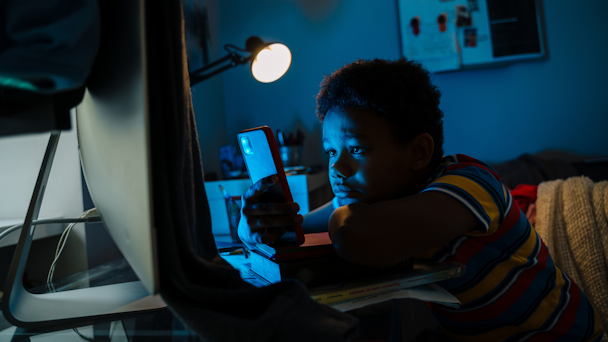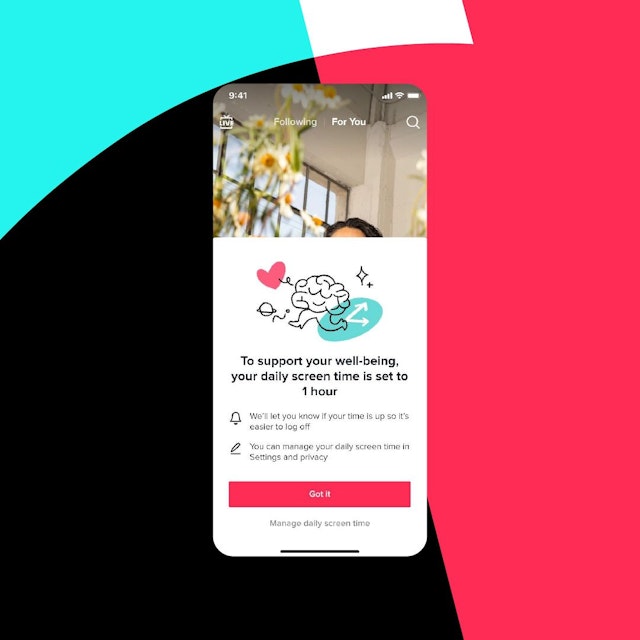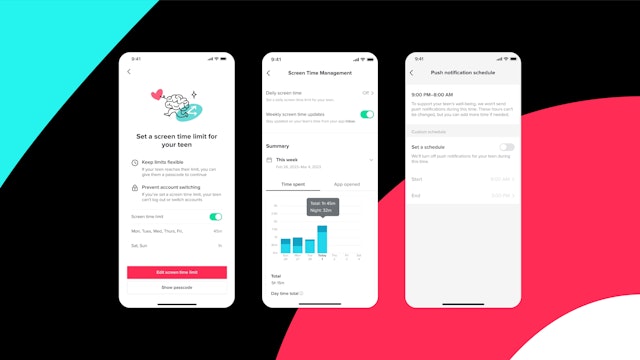TikTok to roll out screen time limits for teens – here’s what it means for advertisers
The video-sharing app is introducing new features designed to empower users to limit their screen time. But with settings that can be easily overridden, experts don’t believe the changes will be especially impactful to users or advertisers on the platform.

The average TikTok user now spends about 95 minutes per day on the app / Adobe Stock
TikTok today announced it’s debuting new default settings to cap screen time to one hour a day for users under 18. It’s also rolling out a range of additional parental controls and settings that allow families and individual users to set limits on and monitor screen time.
The news comes as TikTok faces growing scrutiny from lawmakers and advocacy groups who have expressed concern not only about its algorithm promoting unhealthy levels of engagement (with the average TikTok user spending 95 minutes per day on the platform, per data from Sensor Tower) but also about the app’s data security and privacy risks under the leadership of Chinese tech company ByteDance.
Today, a House committee voted to advance a bill that, if passed into law, would make it easier to ban TikTok in the US altogether. Though the legislation has received backlash from some policymakers and activists concerned with the liberties of online speech, the bill was fast-tracked by Foreign Affairs Committee Chairman Michael McCaul after being introduced on Friday.
TikTok condemned the decision to advance the bill in a statement shared today, writing: “A US ban on TikTok is a ban on the export of American culture and values to the billion-plus people who use our services worldwide. We’re disappointed to see this rushed piece of legislation move forward, despite its considerable negative impact on the free speech rights of millions of Americans who use and love TikTok.”
The move came on the heels of another decision this week by the Biden administration that will require government agencies to remove TikTok from all federal devices within 30 days.
Meanwhile, concerns about social media-related mental health issues among teens are reaching a fever pitch (with the news last year that Meta concealed internal research about Instagram’s negative effects on teen girls’ mental wellness), which is generating more scrutiny of TikTok.
The app is attempting to address some concerns with new screen time controls, which will roll out to all users soon. In particular, changes seek to address concerns about high engagement levels among teens.

Users under 18 will see an automatic 60-minute daily limit applied to their account. When they hit the limit, they’ll be prompted to enter a passcode in order to override the limit and continue using the app. If these users then hit 100 minutes, they will be met with a request to set a new limit for themselves. Teen users will also get a report that recaps their screen time delivered to their inbox each week.
The new settings build on an update launched last year that encouraged teens to enable screen time management tools on the app – a move that TikTok claims helped to increase the use of the tools by 234%.
TikTok worked with researchers from the Digital Wellness Lab at Boston Children’s Hospital to determine how stringent their screen time restrictions should be for young users.
Advertisement
A benefit for users (and advertisers)?
The new changes will benefit users – though the scope of that impact is questionable, experts reckon. “It’s a positive step for TikTok in terms of providing the tools and features to help people manage their time on the app and have a more meaningful experience,” says Matt Navarra, a leading social media consultant and influencer.
Despite this optimism, Navarra remains skeptical that TikTok’s power of engagement will be diminished by new controls. “The addiction to TikTok – the power of its algorithm and all of the other elements at play that drive people to spend hours scrolling, are going to be far more powerful than these tools and features.” Ultimately, he predicts that the “willpower people will have to stand up against” TikTok’s engrossing algorithm will “be tested and crumble quite quickly.”
Advertisement
Other experts echo the sentiment. “I hate to be a doubter over an initiative that's a step in the right direction, but it's a tough one to enforce, isn't it?” says Ann Handley, a digital marketing influencer and consultant. She predicts that most young users will override the pre-programmed limits or even resort to lying about their age on the app to get around them. “I'm imagining the headlines six months from now: ‘TikTok announces user base exploded in the 40+ demographic,’” she jokes.
For these reasons, the changes themselves may not have a major impact on user behavior – or on TikTok’s massive ads business, Navarra says. Though he acknowledges that some advertisers may be concerned about reduced exposure, he believes the impact will be minimal. “From an advertiser’s point of view, if you've got features that are going to slightly reduce or limit people's time spent on the platform, that might not be the thing you want to hear … but it won’t have a significantly meaningful impact on advertisers campaigns at this stage,” says Navarra.
Suggested newsletters for you
Others, however, believe the changes could actually benefit advertisers by supporting information retention and, as an extension, brand recall. “When it comes down to it, sometimes less is more – when we limit time spent with something, the more we tend to enjoy it and remember it,” explains Linda Xiao, the North America director of creative technology and strategy at experiential agency Momentum Worldwide.
She points to the peak-end theory in psychology, which spells out humans' natural bias to remember “the highlights, lowlights and the end of an experience,” which of course means that “we don’t remember everything exactly as it was.” So, Xiao goes on to say, “with endless scrolling and improper digital hygiene, we are eroding on our ability to form memories and hurting brand recall in the long run as marketers’ efforts are constantly replaced over and over by the next best thing.” With limits on how much content a user consumes, they may be more likely to remember the ads they encountered during their time on the app.
As it stands, TikTok’s ads business is booming – the company is on track to hit $18.04bn in ad revenue this year, a 55% lift from 2022, according to data from Insider Intelligence’s eMarketer. Brands are funneling more and more dollars into TikTok and other emerging platforms – in fact, recent reports find that for the first time in nearly a decade, Google and Meta are not expected to eat up more than half of all digital ad spend in the US market.
New family controls come into play
In addition to changes for teen users, TikTok also says it’s rolling out new controls within its Family Pairing program. Parents and caretakers will now be able to set a custom daily screen time limit for their teens, which can be tailored differently for each day of the week. They will also have the ability to establish a schedule to mute notifications to their kids’ accounts. As it stands, the app automatically disables push notifications at 9 pm for 13-15-year-old users and at 10 pm for 16-17 year-olds.

Furthermore, Family Pairing will now give parents and caregivers access to a dashboard where they can see details about time spent on TikTok, the number of times the app was opened, and a more detailed breakdown of time spent on the app during daytime and nighttime.
The new features aim to encourage caregivers and young users to work together to keep TikTok consumption healthy, according to Larry Magid, president and CEO of ConnectSafely, a nonprofit organization that aims to educate users about safety, privacy and security online. In TikTok’s announcement today, Magid said: “Family Pairing is an opportunity for parents and teens to collaborate on developing healthy online habits. It’s not parental control, it’s parental involvement and an opportunity for parents and teens to learn from each other."
TikTok also said today that it will soon allow all users to set their own custom screen time limits for each day of the week and also set a schedule to mute app notifications. Plus, TikTok is introducing a sleep reminder that enables all users to set a specific time for the app to remind them to put down their devices and get some rest.
TikTok declined a request for additional commentary.
For more, sign up for The Drum’s daily US newsletter here.

